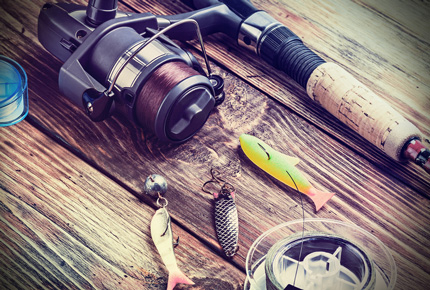Are you a fisherman looking for a secure mono to braid knot? Check out how to tie the versatile Albright Knot with easy instructions for every step.

With the increase in popularity of braided lines, it’s even more important than ever for a fisherman to have the know-how to tie a decent knot.
Using monofilament or fluorocarbon for the leader remains ever-popular, not least because of the stretch and the better visibility. Therefore, a good mono to braid knot is essential, and if you’re planning on landing some larger specimens, you’re going to need to be sure it will hold.
The Albright Knot, also known as the Albright Special is a knot that many fishermen prefer. It’s not particularly easy so you’ll need to practice before you head out to the water, but with a little patience, it’s a type of splice that everyone can master.
If you want to give it a go, the easy-to-follow instructions below will guide you through each step.
Some of the links below are affiliate links, meaning, at no additional cost to you, we may make a commission if you click through and make a purchase.
Why Choose an Albright Knot?
There are many occasions when you might want to join two lines together, a feat that isn’t as easy as it sounds if they have different diameters. Rather than using hardware, you can rely on an intermediate knot instead that’s very popular with fishermen everywhere: the Albright Knot.
When it’s pulled tight, it is extremely slick and neat and won’t spook the fish by adding bulk. The sleek lines will also won’t affect your cast by catching on the line guides.
The knot is named after the man that invented it in the 1950s for tarpon fishing, Jimmy Albright.
Lines of different diameters are easily joined using the Albright Knot. You can use it to attach the backing line to the fly line, as well as using it for a range of other fishing purposes.
The attachment is extremely strong and tough and can be used for carp fishing and sea fishing, as well as being suitable for smaller fish. This makes it an extremely versatile type of knot.

How to Tie an Albright Knot
If you’re ready to get started, here’s how to tie mono to braid in just a few simple steps:
- Take the thicker line and double it back on itself to make a loop.
- Run the mono through the loop you’ve just created; you’ll want approximately 10” of the line pushed through.
- Holding the loop firmly together at the base, take the mono that you’ve just threaded through and pass it under the loop close to your fingers.
- Wrap the mono back over the two strands of the loop and also back over itself where it initially threaded through.
- That makes one complete wrap. Repeat the process nine more times until you’ve got ten wraps lying neatly alongside each other. These should almost reach the top of the loop.
- Begin to make another wrap but after you’ve passed it over, instead of bringing it all the way back, tuck it into the loop. This means the mono should be passing back out of the loop at the same place as the other end of the mono enters it.
- At this point, you should have two strands (either end) of the same piece of mono poking out of the top of the loop. The rest of the loop should be wrapped up tightly to itself, bound by the wrapped mono. At the bottom of the loop you should have a small amount of line sticking out of the bottom where you originally folded the thicker line in half to make the loop.
- Hold both strands of the thicker line and slide the wraps up to the very top of the loop.
- Pull-on the two strands of mono to tighten up the knot and then clip the loose ends at both the top and bottom.
For extra strength, such as when tying braid to fluorocarbon, you can double over the thinner line you’re threading through. The whole process is the same, but you’ll be working with a doubled-over thin line instead. This type of knot is known as the Double Albright.
Top Tips
The process for creating an Albright Knot may sound complicated the first time you try it but once you’ve gotten the hang of it, you realize just how simple it actually is. In a nutshell, it’s nothing more than a loop with the other line threaded through, looped around and threaded back through the original hole. Doesn’t that sound simpler?!
There are however a few tips which will help you polish up your technique and end up with a much smoother knot:
- Moisten the knot before you pull on it to tighten at the end.
- Always make sure the loop is made with the thicker or heavier line.
- You can add a dab of rubber-based cement if you want to make the knot extra-secure.
- The final wrap can be completed either way, with the thread entering back into the loop from either the front or the back. The only crucial part is that it exits the loop on the same side as it went in.
- It’s important to keep the wraps neat as you wind them around the loop. This helps to preserve the integrity of the knot during use. To facilitate this, use your fingers to hold each wrap in position underneath as you’re winding the mono around.
Don’t miss our awesome fishing glossary for those new to the game!
Alternative Knots
Every fisherman has their favorite knot which they turn to when they need to rely on an unbreakable connection. Some of the alternatives to an Albright Knot include:
- Blood knot – only useful for two lines which have the same diameter
- Nail knot – won’t hold for the larger fish, unlike the Albright
- Slim beauty knot – much more difficult to tie.
An Accomplished Art
Once you’ve tied an Albright Knot a few times, you’ll find it so easy that you’ll be able to do it virtually with your eyes closed! Those first couple of times can be fiddly with so many strands to contend with but use your fingers to hold everything in place and you’ll find that it comes together very quickly.
There are few other knots like the Albright, allowing you to join completely different types of line together securely and giving you the choice of where you want to fish.




